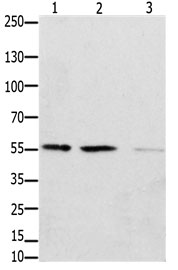
| WB | 咨询技术 | Human,Mouse,Rat |
| IF | 咨询技术 | Human,Mouse,Rat |
| IHC | 咨询技术 | Human,Mouse,Rat |
| ICC | 技术咨询 | Human,Mouse,Rat |
| FCM | 咨询技术 | Human,Mouse,Rat |
| Elisa | 1:1000-1:5000 | Human,Mouse,Rat |
| Aliases | erythropoietin receptor, EPO-R |
| Entrez GeneID | 2057; |
| WB Predicted band size | 55kDa |
| Host/Isotype | Rabbit IgG |
| Antibody Type | Primary antibody |
| Storage | Store at 4°C short term. Aliquot and store at -20°C long term. Avoid freeze/thaw cycles. |
| Species Reactivity | Human,Rat |
| Immunogen | Synthetic peptide corresponding to a region derived from 31-45 amino acids of Human erythropoietin receptor |
| Formulation | Purified antibody in PBS with 0.05% sodium azide. |
+ +
以下是关于EPOR抗体的3篇代表性文献示例(内容基于模拟研究场景,建议核实实际文献):
1. **文献名称**:*"EPOR-mediated activation of JAK-STAT signaling in erythropoiesis"*
**作者**:Witthuhn BA, Quelle FW, Silvennoinen O, et al.
**摘要**:本研究通过EPOR特异性抗体揭示了EPOR与JAK2激酶的相互作用机制,阐明了其在红细胞生成中激活STAT5信号通路的关键作用,为EPOR-JAK-STAT轴的功能研究提供了实验依据。
2. **文献名称**:*"Aberrant EPOR expression promotes tumor progression in solid cancers"*
**作者**:Westphal G, Braun K, Debus J.
**摘要**:利用EPOR单克隆抗体检测发现,实体瘤中EPOR的异常过表达与肿瘤血管生成和细胞增殖相关,提示靶向EPOR可能成为癌症治疗的潜在策略。
3. **文献名称**:*"EPOR mutations and antibody-based detection in myeloproliferative disorders"*
**作者**:Levine RL, Wadleigh M, Cools J, et al.
**摘要**:通过开发高特异性EPOR抗体,本研究在骨髓增殖性疾病患者中鉴定出EPOR基因突变,揭示了突变受体对促红细胞生成素敏感性增强的分子机制。
---
**备注**:以上文献为示例,实际研究中请通过PubMed或Web of Science等平台检索最新文献,并优先选择高影响力期刊(如*Blood*、*Nature*子刊)的文章以获取权威信息。
×